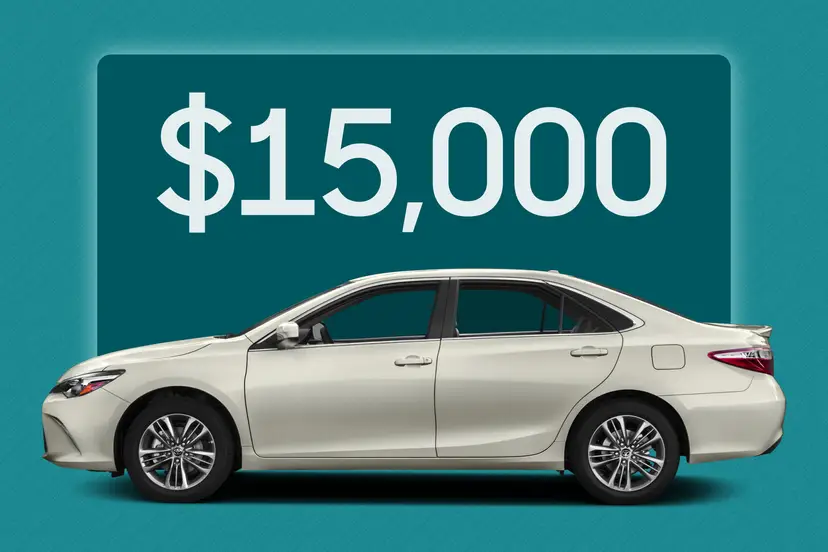
The verdict: The refreshed 2017 Ford Fusion is improved in key areas, including a better multimedia system, updated safety technology and driver aids that enhance the car’s satisfying cabin and driving experience.
Versus the competition: The Fusion offers a more robust feature set and has the best technology integration and a higher-quality interior than its peers, but consumers will pay a premium for that quality.
Though Ford has given the 2017 Fusion midsize sedan an extensive refresh, it’s easy to miss at first glance. Not much has changed on the exterior, but big updates to the interior, safety systems and technology make this a smarter, savvier Fusion. It impressed me with how well it drove and how easy it was to live with. Compare the 2017 Fusion with last year’s model here.
The Ford Fusion competes in a crowded class against popular cars like the Toyota Camry, Honda Accord and Volkswagen Passat, the last of which recently won our 2017 Midsize Sedan Challenge. See how the 2017 Fusion compares with those cars here.
Two new trim levels have been added to the Fusion for 2017: Sport and Platinum, which join the returning S, SE and Titanium models. I tested both an SE and a Platinum. The Ford Fusion Sport model isn’t set to debut until late summer.
Exterior and Styling
At first glance, it doesn’t seem that much on the exterior has changed; the styling of last year’s model is still very much intact. The grille has been widened slightly, and Titanium, Sport and Platinum models get updated headlight clusters with LED headlights (they’re optional on the SE). These changes give the front some added sleekness, but you’ll be hard pressed to tell one apart from last year’s model, even at a short distance.
Sixteen-inch alloy wheels, a chrome grille finish and LED taillights are standard, while the SE adds 17-inch nickel wheels and LED daytime running lights. Titanium models get even more exterior features, including 18-inch wheels, a rear spoiler, dual exhaust and power side mirrors (which include memory on Titanium trims). To that, Platinum models add a unique grille and 19-inch wheels.
Sport models have a bunch of visual cues to hint at their performance potential, including 19-inch alloy wheels, deeper front air inlets, a black mesh front grille and quad exhaust pipes.
How It Drives
I drove two of the three engines that carry over essentially unchanged from 2016, but not the one that’s new for this year: a 325-hp, twin-turbo 2.7-liter V-6, available in Sport trims. The Ford Fusion SE I tested came with the smaller, 1.5-liter EcoBoost engine and standard front-wheel drive, while the Platinum I drove had the more powerful, 2.0-liter EcoBoost and AWD.
I came away from driving both engines feeling slightly underwhelmed. Power is there when you need it from both of the turbocharged four-cylinders – boasting 181 and 231 horsepower, respectively — but you have to work to get it. The engines’ tuning (and the transmission’s shift logic) seemed more suited to gas mileage than performance. The 1.5-liter engine can be had only in the SE, while the 2.0-liter is optional in the SE and standard in the Titanium and Platinum. The base engine, which is standard in the S and SE, is a 175-horsepower, 2.5-liter four-cylinder. A six-speed automatic is the only transmission option, and it gets paddle shifters in Titanium and Platinum models.
What did impress me about the Ford Fusion was its athleticism. Our editors praised the handling and ride of the previous generation, and those characteristics remain. The platform’s rigidity is evident when the road gets bendy, and the Fusion clearly knows how to take a corner (or 10). I also found the suspension to be pliant and comfortable in everyday use, as well — a happy medium.
For 2017, the 1.5-liter EcoBoost engine adds stop-start capability to improve fuel economy. Ford’s execution of this kind of system is typically top-of-the-line, and this application is no exception. After a few hours in the car, I started to forget the feature was there. Startup happens seamlessly and quietly, without much hesitation.
The Fusion Sport’s new engine has much more power than you’ll find in anything else in this class, and it also boasts standard all-wheel drive and an adaptive suspension that adjusts firmness on the fly. With these enhancements, Ford aims to have the only bona fide performance sedan in this class.
The Fusion’s gas mileage puts it toward the bottom of the midsize body type class. EPA-estimated fuel economy for the base engine is 21/32/25 mpg city/highway/combined. The 1.5-liter EcoBoost gets the best marks, at 23/34/27 mpg, while the 2.0-liter EcoBoost returns an estimated 21/31/25 mpg with front-wheel drive and 20/29/23 with all-wheel drive. Each of these engines takes regular fuel.
Interior
Inside, the Fusion gets a redesigned center console. The conventional shifter is gone, replaced by a rotary shifter, which opens up space for added storage and makes for a less cluttered design.
Though not as large as some competitors’, I found the Ford Fusion’s backseat to have enough room to fit adults in the outboard seats comfortably for longer trips.
Titanium models add leather-wrapped upholstery, but the real star is the Platinum, which gets quilted leather seats that I really liked. In fact, I found the Platinum’s fit and finish to be on par with most luxury vehicles, and it was very quiet and comfortable on the road.
Ergonomics and Electronics
The Fusion’s multimedia system got a major update for 2017, with the addition of Sync 3 and a few other helpful technologies. Sync 3 is the best iteration of Ford’s Sync system to date; its usability and responsiveness have both gotten much better. As car multimedia systems go, Sync 3 is at the top for me alongside Uconnect, which is found in Fiat Chrysler America vehicles.
Sync 3 is available as an option starting on SE models, and it’s standard on Titanium and Platinum trims. Coming along with it are Apple CarPlay and Android Auto, which give users even more flexibility. Paired with Sync, these smartphone interfaces are a way to incorporate on-screen navigation functionality without paying extra for the factory navigation system, which is an additional option.
Ford is also introducing a new technology for 2017, called Sync Connect. The system adds cellular hardware to the car itself, allowing remote access to features like lock/unlock, vehicle status reports and remote start via a smartphone app. Sync Connect is available on Titanium trims and standard on the Platinum.
Charging points for portable devices have also proliferated in the Ford Fusion refresh. There are two 12-volt outlets and two USB ports up front, plus another 12-volt outlet and an optional 110-volt household socket in back for even more charging. On higher trim levels, those USB ports charge at 2.5 amps (versus 1.5 amps on lower trims). That’s better suited to charging phones (and even tablets) quickly.
Cargo and Storage
The Fusion has 16.0 cubic feet of cargo room, which puts it at the top end of the pack (the Passat, Accord and Camry have between 15.4 and 15.9 cubic feet). A 60/40-split folding backseat is standard on all trim levels.
Interior storage has gotten much better with the new rotary shift knob and redesigned console. The low-profile knob makes it easier to access the large storage cubby under the climate controls, and there’s a new pocket lined with grippy leather designed to hold your phone in place, either upright or lying on its side.
Safety
The Fusion’s refresh added many safety features and driver aids, and the Platinum model I tested came with all of them.
While many of the features themselves are not completely new to the Fusion, Ford added lots of functionality to them. The forward collision warning with automatic emergency braking, for instance, gets pedestrian detection; park assist can now steer into perpendicular spaces in addition to parallel parking; and the adaptive cruise control adds stop-and-go capability. Stop and go means the system won’t automatically shut off as the car comes to a stop, like many other systems do. So when you’re in bumper-to-bumper traffic, the Fusion will come to a complete stop then proceed on its own once traffic starts moving again.
The adaptive cruise control impressed me. I live in a high-traffic area, so having the system work in dense congestion is a godsend. If you’re stopped in traffic for more than three seconds the system turns off, but just a press of the “resume” button or a tap of the gas pedal is enough to get it started again. One other thing I liked: Some systems turn off once the car stops then let the car start to roll forward, but the Fusion keeps the brakes engaged, keeping you in place until you tell it to move again.
Forward collision warning, blind spot warning, park assist and adaptive cruise control are not available on S models but are optional on SE and Titanium trims. Platinum models get everything standard.
Equipped with front crash prevention technology, the 2017 Ford Fusion earned the Insurance Institute for Highway Safety’s highest ratings in all categories. See a comprehensive list of the Fusion’s safety features here.
Value in Its Class
This class is tightly bunched when it comes to price, and the Ford Fusion mostly falls in line with the competition. S models start at $23,485 including an $875 destination charge, while the SE is $24,485 and the Titanium checks in at $31,485. At the top end of the spectrum, however, the Fusion Platinum pushes the segment’s price limit to new heights, starting at $37,495. As equipped, the Platinum vehicle I tested was higher still: $40,080 thanks to added all-wheel drive, inflatable rear seat belts and its burgundy red paint (seen in the photos).
That’s a lot of scratch, considering a Camry with an upgraded engine and all the safety/technology boxes checked costs only $35,075. An Accord in the same configuration comes to $35,665 and the Passat is $35,090.
Characterizing the Fusion’s value is a difficult proposition. Even if you drop down to a Titanium, adding those advanced safety features pushes the price tag to $34,995 — and you’ll still be missing navigation, which is present on its competitors at that price. The Platinum, however, has the best interior and more features/technology (with better integration) than any of its competitors. The Ford Fusion’s price tag will dissuade some buyers, but the good news is, at least if you opt for a Platinum, you’ll get what you pay for.
Cars.com’s Editorial department is your source for automotive news and reviews. In line with Cars.com’s long-standing ethics policy, editors and reviewers don’t accept gifts or free trips from automakers. The Editorial department is independent of Cars.com’s advertising, sales and sponsored content departments.












































